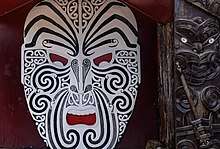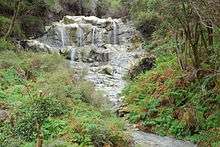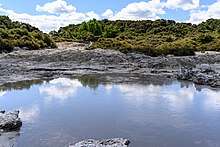Tikitere
Tikitere, also known as "Hell's Gate", is a suburb in Rotorua's most active geothermal area[1] on State Highway 30, between Lake Rotorua and Lake Rotoiti in the Bay of Plenty, New Zealand. It includes many geothermal features such as steaming lakes, mudpools, fumaroles, a mud volcano and the Kakahi Falls, the largest hot waterfall in the southern hemisphere.[2]
The area is operated under the name "Hells Gate", and offers self-guided and guided tours of the geothermal park, information about its history and Māori culture, and a mud spa.


History and culture
The thermal area was formed approximately 10,000 years ago in a series of geothermal eruptions that drained an ancient lake and formed the Lake Rotoiti and Lake Rotorua. The absence of the pressure of the water on top of the rock caused it to create faults from which steam and gases can escape. At less than 2 km below ground, the heat source of this thermal area is shallower than most other thermal areas in the region.
The local Māori tribe Ngāti Rangiteaorere has lived in this area for more than 700 years and remain the owner of this geothermal attraction.[3] Tikitere, the Māori name for the area is derived from the tragic action of a Māori princess, Hurutini, the young wife of an abusive and shameful chief, who threw herself into the boiling hot pool that bears her name today. Upon finding her daughter's body floating in the hot pool, Hurutini's mother cried out a sad lament "Aue teri nei tiki" ("here lies my precious one"), which was shortened to Tikitere and became the name from the thermal reserve and the surrounding area.
"Hells Gate", its most commonly known name, was used following the visit to the geothermal reserve by noted Irish playwright, George Bernard Shaw in 1934 who likened the area to the comments that were made by his theologian colleagues back in England who were explaining to him that the result of the error of his ways as a practising atheist would result in his "going to hell".[4] What he saw at Tikitere moved him to believe that this would be the gateway to hell. His visit to Tikitere was well received by the local Māori owners of the land and as an honour to note the occasion of his visit, the owners decided that this would be the English name for the geothermal area. A destination spa operated at this site as early as 1871, using sulphurous waters from one of the hot pools and from Kakahi Falls.
The Tikitere urban area includes Waiohewa Marae and Rangiwhakaekeau meeting house,[5] belonging to Ngāti Rangiteaorere.[6]
Attractions

The features of the 50 acres (20 ha) geothermal park can be explored via two easy-walking, relatively flat loop walks, taking 45 to 60 minutes in total.
The lower area is encircled by a loop walk with bridges and viewing platforms, and contains about a dozen hot pools such as "Sodom and Gomorrah" and "Devil's Bath", with depths of 15 to 25 metres. The water in the "Inferno Pools" and "Sodom and Gomorrah" reaches more than 100 °C (212 °F) due to minerals in the water elevating its boiling point. Sodom and Gomorrah, named so by Shaw, has on occasion erupted 2 metres out of its pool. Most of the other pools have temperatures of 60 to 70 °C (140 to 158 °F). The water from the Huritini hot spring is used in Hells Gate's sulphur spas. The pH level of the water in the pools is typically 3.5 to 5, with the more acidic "Ink Pots" having a pH level of 2, and the "Sulphur Bath" reaching pH 1. Several other geothermal features in this area also bear names given by Shaw.
Separating the lower and upper area is a short easy-walking bush walk along the stream flowing over the Kakahi Falls. This 4 metres tall cascade is the largest hot waterfall in the southern hemisphere and has a water temperature of around 40 °C (104 °F). The waterfall has always been a special place for local Māori, with warriors using it to cleanse themselves after battles, the sulphur in the water disinfecting wounds. The waterfall's full name is "O Te Mimi O Te Kakahi", named after a chief and noted warrior of Ngāti Rangiteaorere.[7] The stream itself is the overflow from the upper geothermal area.


A larger loop walk takes in the upper geothermal area, which contains expansive hot pools of varying activity as well as steaming fumaroles. Sulphur crystals can be observed in some parts of this area, as well as several mud cauldrons with boiling black mud. This area also contains a large mud volcano, which is currently around 2 metres tall. Mud typically bubbles violently in the crater of the volcano, but the mud volcano hardens roughly every 6 weeks. A mud eruption follows pressure build-up over 2-3 days, splattering mud over 2 metres around the volcano.
The Steaming Cliffs pool has the highest temperature of all pools in this geothermal area at 122 °C (252 °F) at the surface. Other pools in the upper area range from around 40 to 90 °C (104 to 194 °F) and were traditionally used for cooking, and medicinal purposes such as treating skin diseases and arthritis. The grey mud and water from one of the pools is used in Hells Gate's mud spa.
Hells Gate's mud spa, adjacent to the entrance, offers mud footpools and several mud baths, and a list of mud packages, therapies and massages. Mud-based beauty products available at the on-site shop. Hells Gate also offers educational programmes for schools.[8]
Education
Te Kura Kaupapa Māori o Ruamata is a co-educational state Māori language immersion school for Year 1 to 13 students,[9] with a roll of 255 as of March 2020.[10]
References
- "Tikitere - Volcanic Plateau places". Te Ara: The Encyclopedia of New Zealand. Retrieved 2014-09-06.
- "Top 5 Geothermal Wonders in Taupo & Rotorua". New Zealand Tourism. Retrieved 2014-09-06.
- "The History of Hells Gate and the Rotorua area". Hells Gate. Retrieved 2014-09-06.
- "Lake Rotorua - Volcanic Plateau Places". Te Ara Encyclopedia of New Zealand. Retrieved 2014-09-06.
- "Māori Maps". maorimaps.com. Te Potiki National Trust.
- "Te Kāhui Māngai directory". tkm.govt.nz. Te Puni Kōkiri.
- "Kakahi Falls". Hells Gate. Retrieved 2014-09-06.
- "Education at Hells Gate Geothermal Park, Rotorua". Hells Gate. Retrieved 2014-09-06.
- "Ministry of Education School Profile". educationcounts.govt.nz. Ministry of Education.
- "Education Review Office Report". ero.govt.nz. Education Review Office.